
When Angela Miles walked through East Falls last Tuesday, she was delighted to watch residents heading toward the polls and peering at a “Vote Here” sign she’d created outside the local library.
A Philadelphia-based graphic designer and stained glass artist, Miles accented the piece with campfire-colored slices of glass.
“I wanted there to be a sharp color and a brightness to it, especially on a beautiful day like [Tuesday],” Miles said.
Both eye-catching and sun-catching, her sign stood accompanied by two others. They varied in color and style but all proclaimed the same message: “vote here” on one side, and the Spanish translation, “vote aquí,” on the other.
“The result is this incredible public art that’s also very functional,” said Lansie Sylvia, project director of “Next Stop: Democracy,” an organization that worked to increase voter turnout through public art.
During Election Day, signs similar to Miles’ flanked 20 different voting booths citywide. Miles saw the project as an example of the connection between art and change.
“In a lot of ways it’s public service,” Miles said. “It wakes people up, it invites people in, it’s peaceful. If it’s unsettling then it’s to spark a conversation.”
Pennsylvania law states that 10 feet away from the polling room, people can display any kind of information they want.
“Usually people exploit that for partisan purposes, to help, just hand out flyers about certain candidates and to encourage people to vote a certain way,” Lansie said. “But as a nonpartisan program, [we were] just there to help people find where they’re going.”
Through a submission process, 60 different artists worked on the signs, contributing their own distinctive styles. Isaiah Zagar, founder of the Philadelphia Magic Gardens, submitted a sparkling mosaic piece, while anonymous street artist Kid Hazo provided a signature parodic infographic.
Jason Andrew Turner, an artist who recently moved from Philadelphia to Brooklyn, contributed an American flag-themed piece. Turner said Philadelphia’s community-based attitude helped make “Next Stop: Democracy!” possible.
“I mean, the sign project would not have been able to work in New York in the way that it could in Philadelphia,” Turner said. “It’s just a scene that really embraces its artists, that really embraces movements in a way that is community-driven and really grassroots.”
The project, equipped with artists, statisticians, musicians and managers, displayed an eclectic network of contributors. “Next Stop” collaborated with research faculty at the University of Pennsylvania to calculate a socio-economically diverse set of locations.
Conrad Benner, a local digital curator of street art, played a role in the movement by helping to create what Lansie referred to as a “robust” social media presence.
Aiming to give the city a celebratory vibe on Election Day, “Next Stop” also planned several pop-up performances throughout the city.
Schools and civic groups, however, found the idea of live music, dance and comedy too partisan and turned the organization down, allowing for only one performance to take place on Tuesday.
“We heard from one school, ‘We just feel like encouraging people to vote is a little too political for us,’” Lansie told Newsworks. “That was something we heard from sponsors and potential partners. Just the idea of a get-out-the-vote effort felt too political.”
While the signs received enthusiasm on social media, the voter turnout evaded the hopes of “Next Stop” when it did not improve.
According to the Office of the Philadelphia City Commissioners, the voter turnout dipped from 27 percent in 2014 to less than 26 percent in this year’s Nov. 3 election.
Hopeful for an increase in voter turnout, Lily Meier positioned her sign at a location near her workplace, so that she could check on it throughout Election Day. An architect and collage artist, Meier contributed a piece based on a 1950s advertisement for housewives.
“I think this project was a really good reminder to me and hopefully also to the people who see the signs that the option that we have to vote should be celebrated and recognized and really not taken for granted,” Meier said.
CORRECTION: In a version of this article that also appeared in print, Jason Andrew Turner was misidentified as Andrew Jackson Turner.
Angela Gervasi can be reached at angela.gervasi@temple.edu.



Be the first to comment